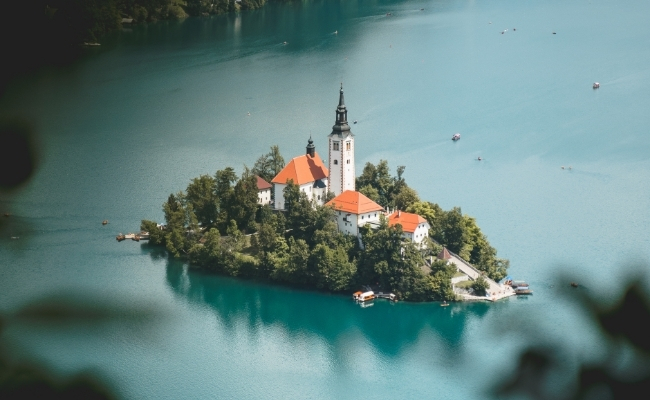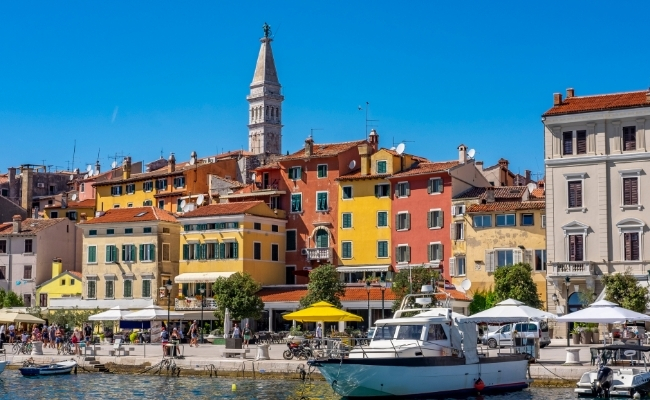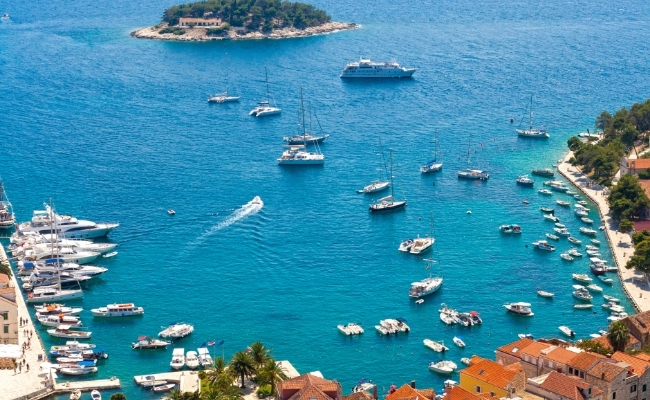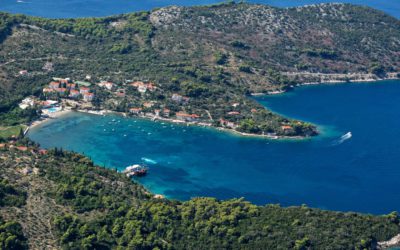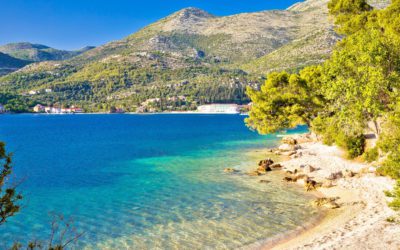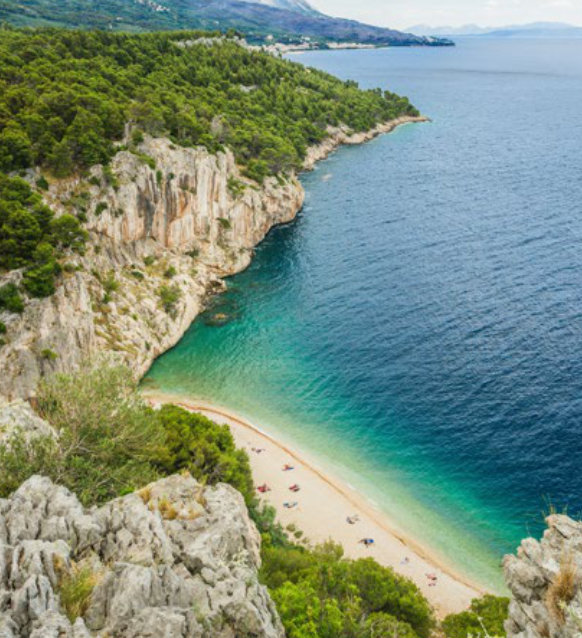Wine & Culinary Delights – Exclusive
Croatia Tours (private journeys) | Food & Wine
10 Day private, customizable land tour – Perfect for Foodies!
Visiting: SPLIT – HVAR – PAG – ROVINJ – BUZET – LAKE BLED – LJUBLJANA
Croatia is one of the most interesting and richest culinary regions of Europe. Dating back to the 8th century B.C., the area now called Croatia has cultivated and consumed fresh local ingredients. Over time, there were many incursions and invasions of this land, and cross-fertilization of culinary tradition took hold. Today’s healthy cuisine unites Mediterranean, Central European, and Eastern influences – think Vienna, Istanbul, Tuscany, and Venice.
It is uniquely Croatian cuisine now – in harmony with the climate of the region. Join us on our exploration of culinary and vineyard delights in this beautiful destination.
Highlights
Itinerary
Day 1: Split
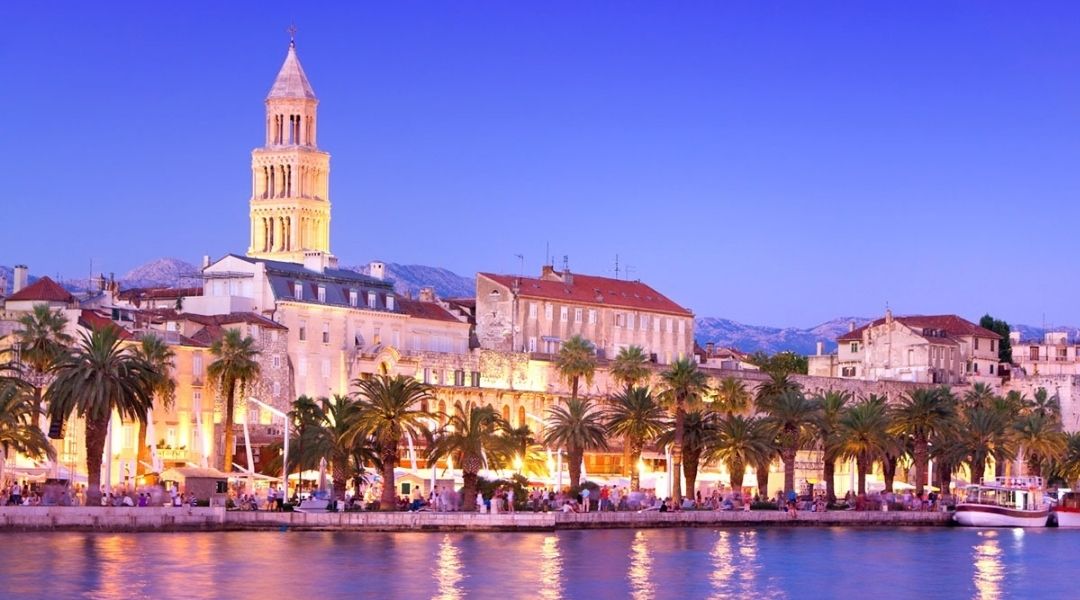
Itinerary
- Arrival to Split, meeting with your driver, and a private transfer to your centrally situated hotel
- Meeting with your guide for a private walking tour of Old Town Split
- Welcome dinner at Restaurant, followed by time at leisure and overnight in Split
Day 2: Split – Krka National Park

Maybe not the most important but certainly the yummiest must-do activity of all – food! Split, especially its Old Town, is literally dotted with colorful food stalls, konoba (a type of traditional Dalmatian tavern), and quaint little restaurants. Don’t miss local delicacies, such as grilled (na gradele) fish and pašticada. Street food culture in Split is also pretty strong and you can never go hungry since there’s always some inviting bite-sized treat waiting for you around the corner. The largest part of this amazing river’s course is the national park, which, in addition to its natural phenomena, abounds with cultural and historical monuments. The most outstanding of these is the Franciscan monastery on the tiny island of Visovac, set in the middle of the river widening like a precious stone. Within the monastery, there is a picture gallery and a church, origins of which are traced back to the 14th century. In the middle of the canyon, upstream of the river, is an interesting Krka Orthodox monastery; while on the high ground above the river several old ruins sit. The old mills, which have been transformed into small ethnographic museums, are a popular attraction for visitors. Heritage interpreters are dressed in traditional folk costumes, which is particularly interesting and entertaining for children, who are frequent visitors of the park. However, the main attraction of Krka National Park is its seven waterfalls. The widest of these is Roški Slap, although Skradinski Buk is the biggest and most well-known. A famous winery is located very close to Skradin, on the coast in North Dalmatia. This region is known for its famous grape. The family started making wine more than a hundred years ago, with the winery founded in 1906. This winery achieved international success by making a wide variety of Croatian wines mainly from debit, babić, plavina, and lasin grapes native to the region. We shouldn’t forget the traditional dessert wine of Dalmatia, the Prošek. According to rumors, one of Eva Longoria’s favorite wines is Bibić’s dessert wine, called Ambra.
Itinerary
- Breakfast at the hotel and meeting with your chef for a half-day cooking class, with grocery shopping at a local market and hands-on cooking followed by lunch in Split
- In the afternoon, meet with your driver/guide for an afternoon visit to Krka National Park
- A visit to the Krka National Park, a boat ride to Visovac Island, educational trails, and ethno presentations
- After a short drive, you will reach the small village for a unique wine pairing gourmet experience at world-famed
- Wine Cellar & Tavern
- Return to Split, time at leisure, and an overnight
Day 3: Split – Hvar – Split

A vacation on the lavender island of Hvar means extraordinary experiences every day – from visiting an ancient olive grove and learning about what Homer called “liquid gold”, taking a Jeep safari to discover hidden inland Hvar, to exploring a castle, visiting the oldest theater in Europe or tasting spectacular wine and local delicacies at an award-winning vineyard. The lavender island is what Conde Nast’s signature travel magazine calls “one of the “best 10 islands in the world”. Sv. Stjepana Square – The center of town is this rectangular square, which was formed by filling in an inlet that once stretched out from the bay. At 4500 sq. meters, it’s one of the largest old squares in Dalmatia. The town first developed in the 13th century to the north of the square and later spread south in the 15th century. Notice the well at the square’s northern end, which was built in 1520 and has a wrought-iron grill dating from 1780. Katedrala Sv. Stjepana [Cathedral of St. Stephen] – The cathedral forms a stunning backdrop to the square. The bell tower rises four levels, each more elaborate than the last. The cathedral was built in the 16th and 17th centuries at the height of the Dalmatian Renaissance on the site of a cathedral destroyed by the Turks. Parts of the older cathedral are visible in the nave and in the carved 15th-century choir stalls. Renaissance Theater – Built in 1612, this theater is reportedly the first theater in Europe open to plebeians and aristocrats alike. It remained a regional cultural center throughout the centuries. Plays were staged here right up until 2008. Although much of the theater is still under renovation, you can wander around the atmospheric interior and take in the faded frescoes and baroque loggias. Franciscan Monastery & Museum – This 15th-century monastery overlooks a shady cove. The elegant bell tower was built in the 16th century by a well-known family of stonemasons from Korčula. The Renaissance cloister leads to a refectory containing lace, coins, nautical charts, and valuable documents, such as an edition of Ptolemy’s Atlas, printed in 1524. Your eye will immediately be struck by The Last Supper, an 8m by 2.5m work by the Venetian Matteo Ingoli dating from the end of the 16th century. The cypress in the cloister garden is said to be more than 300 years old. The adjoining church, named Our Lady of Charity, contains more fine paintings such as the three polyptychs created by Francesco da Santacroce in 1583, which represent the summit of this painter’s work. Fortica, through the network of tiny streets northwest of Sv. Stjepana’s Square, climb up through a park to the citadel built on the site of a medieval castle to defend the town from the Turks. The Venetians strengthened it in 1557 and then the Austrians renovated it in the 19th century by adding barracks. Inside is a tiny collection of ancient amphorae recovered from the seabed. The view over the harbor is magnificent, and there’s a lovely cafe at the top. Arsenal – On the southern side of St Stephen’s Square, the Arsenal was built in 1611 to replace a building destroyed by the Ottomans. Mentioned in Venetian documents as ‘the most beautiful and the most useful building in the whole of Dalmatia’, the Arsenal once served as a repair and refitting station for war galleons.
Itinerary
- Breakfast at the hotel and meeting with your skipper for a full day speed boat excursion to Hvar with wine tasting followed by lunch in one of the charming villages
- This tour begins with a drive through the green and very lush island of Hvar. Passing through Brusje, famous for its lavender, and onto the fascinating town of Stari Grad, once known as Pharia and Pharos the island’s once capital
- Continuing through the stone streets along the new Riva, stopping for a coffee, and visiting the fortress “Tvrdalj” once belonging to the poet Petar Hektorović. We continue through the well-known UNESCO-protected vineyards, to a small charming town Vrbovska, also called “Little Venice”. This town in Hvar is named such because of the many small stone bridges that connect the town over its narrow winding canal and the unique St. Mary of Mercy fortress – church
- The next stop is Jelsa, one of the largest towns on the island. It is a hidden secret from the tourist masses. Here you will find the spirit of St. John’s square
- From St. John’s square, we will make our way to the oldest village and the reason for Jelsa’s existence, “Pitve Harbor”. It was built to service the needs of Pitve, the inland village. Enjoy the tranquil stone setting and per a lack of noisy crowds
- As we head back, we will enjoy the charming villages of Vrisnik, Svirče, and Vrbanj and on to our authentic Dalmatian lunch
- Return to Hvar and time at leisure
Day 4: Split – Pag

At first glance, the Island of Pag looks rough, stone-made, edged with the sky-blue sea, and placed under the wing of the Velebit Mountain. It is often called “The Island of Rock ” or “Lunar Island” because its surface has a somewhat intimidating appearance with white stone, rugged in so many forms that only nature can create, that occupies 86% percent of the island’s surface. The island of Pag is known as one of the sunniest islands in the Adriatic, with over 2,500 hours of sunshine per year, its coast is woven of even 270 km of pebbly beaches with crystal clear sea. Among more than a thousand islands in the Adriatic, Pag is quite different from the others; the armor of stone hides away the richness that hardworking hands of islanders were creating for centuries, always struggling much more than others. Under the branches of centuries-old olive trees, at the very northwest of the island, there lies Lun. Nature has left its marks generously in this area in a unique combination of green and blue. If you want to find peace and quiet somewhere in the urban bustle, this is the ideal place for your next vacation. The mild Mediterranean climate and comfortable silence of the Lun olive trees will rejuvenate your strength. In this silence, it seems that time really has stopped.
Itinerary
- Breakfast at the hotel and check out
- Meeting with your driver for a private transfer from Split to Pag Island
- Your tour of the island Pag starts with a cheese tasting tour where you will be told about the technology and process of cheese making and have a chance to taste the award-winning dairy
- After cheese tasting, we head toward Lun to take a walk through the Botanical Reserve and learn about the history of olives and their importance today.
- Onward drive to hotel, check-in to your rooms, and time at leisure
- In the evening enjoy wine tasting with dinner and learn about different sorts of grapes, vineyard cultivation, and how grapevines are grown and cared for while enjoying the best samples of seafood and meat dishes prepared by the house chef
- Overnight on Pag
Day 5: Pag – Rovinj

Rovinj is the most romantic place in the Mediterranean! The town of Rovinj is the right destination if you are seeking a sentimental atmosphere of times gone by. Rovinj has begun its romantic life on an island, its restricted area resulting in crowded houses, narrow streets, and small squares, still untouched by modern urbanism. Built upon a rich fishermen’s tradition, it has become distinctive for its unique boat called batana and its song, bitinada. Its beauty was particularly appreciated by artists who have painted the most beautiful motifs here and exhibited them on Grisia, the street of artists. The old town of Rovinj is the protected historical center of Rovinj with a Town Hall building and a large square lined with renaissance houses from the 16th century, the most appealing part of the town for visitors. The narrow cobbled alleyways and the small squares which have witnessed the turbulent history of the town are full of medieval, Gothic, Renaissance, and Baroque. On the northern side, you will find the remains of the walls used to protect the town’s inhabitants from conquerors and looters as well as Balbi’s Arch from 1679. Walking down the old alleys is a very special experience – you will feel like time has stopped and you have returned to the ancient era. Walking in the historic old town, you will find a new surprise at every step. Church of St. Euphemia, the symbol of the town of Rovinj, other small churches, monuments, old doors, and arches wait behind every corner, and if you find yourself in need of a break and rest, your kind hosts will invite you into one of the numerous restaurants. Visit the old town of Rovinj, the keeper of history and heritage of one of the most photogenic Mediterranean towns walk Bregovita and Švalbina streets, lined with baroque buildings or the Grisia Street where Rovinj artists exhibit their pieces with a personal approach and talk to visitors.
Itinerary
- Breakfast at the hotel and check out
- Private transfer from Pag island to Rovinj via Prizna-Žigljen ferry connection and a stop in local family-owned wineries for wine tastings with snacks
- Onward drive to Rovinj and hotel accommodation
- Meeting with your guide for a private walking tour of Old Town Rovinj
- Return to the hotel and meet with the hotel wine bar manager and sommelier and overnight in Rovinj
Day 6: Rovinj – Istria

The Central Istria Riviera, known as Green Istria, embraces a multitude of small places with a long history and fortresses on hills with picturesque bell towers. Central Istria, as the administrative center of Pazin, “the heart of Istria,” will take you through its labyrinth of narrow streets and paths (suitable for cyclists) through the fascinating landscape of cultural and natural resources: medieval castles on the hills, a forest of truffles, vineyards where tasty Malvasia and Teran ”grow” and olive groves. Before you know it, you will plunge into an absolutely gorgeous atmosphere of hill towns and seaside villages, dramatic beaches and rose gardens, and absolutely delicious wine, olive oil, and truffles.
Journey up the western Istrian coast where you’ll enjoy the views of the Lim channel. Follow the beautiful scenery and the impeccable lines of spacious vineyards to reach Motovun where you can enjoy the unique experience of a truffle hunt. Motovun, the medieval, captivating hilltop town as one of the characteristic symbols of the Istrian interior. It’s an ancient Istrian town-monument, located atop a 277m high hill that dates back to the Middle Ages. The position and views of Motovun make it one of the most beautiful towns in Istrian inland. Our friendly hosts will serve local wine, cheese, and truffle flavored honey, pâté, and other delicacies that you can purchase. After an aperitif, we will go to the forest near the Motovun woods and Buzet – the hometown of truffles. The biggest truffle in the world was found in this area in 2000 (1,3 kg!) with the help of dogs, specially trained to find the underground mushroom using their sense of smell. The annual “Days of Truffles” are held every October, where you can sample dishes made from freshly picked truffles. You’ll visit Grožnjan, the hilltop town of great cultural significance not only in Croatia but also internationally. Every year at the beginning of May, the little streets and squares of Grožnjan-Grisignana turn into truly artistic beehives: it opens its summer music academies for young people, its artistic, dance, and drama workshops, and its peace activism workshops under the leadership of well-known experts and teachers and famous names from music, art, and drama. During those few summer months, Grožnjan-Grisignana lives and breathes art, and the labyrinth of its little streets becomes one great stage on which is constantly changing with sounds of jazz and classical music, guitar, and piano, violin, cello, drum, and vibraphone.
Explore the wine roads and visit two of the most notable Istrian wine producers and uncover the various great tastes of Malvasia, Teran, Muscat, Merlot, and Cabernet Sauvignon reflecting the diversity of climate and soil where they are grown. You will have the opportunity to taste the real flavor of the wines and olive oil of Istria while visiting a local family estate where wines will be paired with light food provided by local farms and small producers with olive oil and served in the wine bar overlooking the mild slopes of Valle vineyard. Taste and learn about the popular Istrian olive oil, with its tasty piquant character through the olive oil tasting. The second winemaker has a different approach and ages his wine, so you can have an excellent vertical tasting of the same wine. This is a great way to witness firsthand how the wine actually develops through different stages.
Itinerary
- Breakfast at the hotel
- Meeting with your guide for a private tour of Istria
- Your tour of Istria starts with a view of the Lim Channel. Then onto Motovun for a 45-minute truffle hunt in afterward, prepare a meal with truffles
- Onward to Grožnjan to view art and culture
- Stop for wine and olive oil tasting at two of the most notable wineries on island Istria
- Onward drive to the hotel, check-in to your rooms, and time at leisure
- In the evening dine on a cuisine that is the result of endless research based on tradition. The delicacies are combined with a rich wine list with over 200 labels as well as with a vast choice of Istrian olive oils. Each seasonal menu has recommendations on which olive oil to use with the chosen dish. Member of the Association des Jeunes Restaurateurs d’Europe, this gourmet restaurant finds itself on the top of the Istrian and Croatian cuisine scene.
- Overnight in Istria
Day 7: Rovinj – Lake Bled

Lake Bled, a town that has existed for a thousand years, sheltered by picturesque mountains, with an Alpine lake. Truly the jewel of Slovenia, Lake Bled has a legendary island in the middle of the lake, a castle, and hot springs. Its beneficial climate has attracted numerous cosmopolitan visitors for centuries. The most renowned symbol of the island is the Church of the Assumption of Mary which demands a climb up the 99 stone-step staircase. As far as the wishing bell is concerned, don’t just watch it, ring it! Climb up to Bled Castle and enjoy the finest view of the lake with its island. Demonstration of printing on a reconstructed Gutenberg’s printing machine and prints of certificates is available.
Itinerary
- Breakfast at the hotel and check out
- Meeting with your driver for a private transfer from Rovinj to Bled and accommodation in your hotel
- Meeting with your guide for a private tour of Bled. You will visit Bled Castle, take a pletna boat ride over the lake and visit the Church of the Assumption of Mary that you reach after 99 steps. The wishing bell is another attraction because when you ring the bell, make a wish and it will be granted
- Special wine paired dinner at Hotel in Bled
- Overnight in Bled
Day 8: Bled– Ljubljana

The Bled Castle offers the finest view of the Bled island, the town of Bled, and of the wider countryside of the Gorenjska region. Experience the picturesque architecture of the castle and the museum collection, representing the historical development of Bled, its culture, and its population. Get familiar with the traditional manual technological procedures of printing in the castle printing shop, order a small bottle of wine and seal it with sealing wax in the castle cellar, and get acquainted with artistic ironworks at the castle forge.
Recover your strength in the castle restaurant and then visit the multi-vision. The town of Radovljica (sometimes shortened to Radol’ca) is filled with charming, historic buildings and blessed with scenic views of the Alps, including Triglav. It was settled by the early Slavs, and by the 14th century had grown into an important market town centered on a large rectangular square, today’s Linhartov trg, and fortified with high stone walls. Much of the original architecture, amazingly, is still standing and looks remarkably unchanged from those early days. It’s an easy day trip from Bled, just 7km away. Stroll the medieval streets and learn about life almost 500 years ago.
Most of the towns have grown in the meantime, but if you know where to look you will find some interesting medieval sights. While in Radovljica, visit the Beekeeping museum (this apiculture museum takes a closer look at the long tradition of beekeeping in Slovenia). The museum’s collection of illustrated beehive panels from the 18th and 19th centuries, a folk art unique to Slovenia, is the largest in the country, and there are some rather astounding beehives in improbable shapes: (life-sized) people, a miniature mansion, even a lion. You can also observe a live beehive in action, filled with a family of indigenous Carniolan bees. Bees are still kept in Slovenia for their honey and wax but much more lucrative are such by-products as pollen, propolis, and royal jelly) or Gingerbread Museum (In the cellar is this small, super-sweet showroom, which demonstrates in living color the particularly Slovenian art of lectarstvo , the making, shaping, and decorating of honey dough into hearts, figures, and so on. It’s cute as a button, with plenty to buy, and even have your custom messages made.
Itinerary
- Breakfast at the hotel and morning at leisure
- In the afternoon, meet with your driver for a drive to Radovljica for a visit to the Beekeeping museum
- After a hearty meal and a traditional Slovenian lunch at a local restaurant, you will be driven to Ljubljana and check-in at your centrally situated hotel.
- A wine tasting in a specialized wine bar and shop in Ljubljana’s City Hall building, a place where both our wine and the people who drink it feel at ease.
- Time at leisure and overnight in Ljubljana.
Day 9: Ljubljana

Both residents and numerous visitors perceive Ljubljana as a city made to the measure of a man. Ljubljana is classified as a mid-sized European city, but it has preserved its small-town friendliness and relaxed atmosphere while providing all the facilities of a modern capital. It is a unique city dotted with pleasant picturesque places where you can expect all kinds of nice little surprises.
Ljubljana Castle lies atop Castle Hill and is a well-known landmark here. This monument has served as military housing as well as the royal residence over the past centuries. The Dragon Bridge truly symbolizes the history, beauty, and architectural style of Ljubljana and adds glamor to its skyline. This is, in fact, the first bridge in the entire world to have been constructed using reinforced concrete. You can identify St. Nicholas cathedral by its twin towers and green colored dome. Built in the year 1707, the church is dedicated to the popular saint of boatmen and fishermen of this region.
To truly enjoy Ljubljana sights and get a feel of the city, you can visit the city market. The picturesque setting near Baroque cathedrals makes it a nice place to visit. You can buy all kinds of fresh fruits and vegetables, spices, herbs, local arts, and crafts and Slovenian delicacies like horse pâté, Karst prosciutto, oils, cheeses, ‘potica’ cake, and more. The town’s main square was destroyed by an earthquake in the 15th century and was later remodeled in true Baroque style. The square is home to the Souvan House, City Art Museum, Town Hall, and the ancient Lichtenberg house. Preseren Square has a statue of France Preseren, Slovenia’s most famous poet. In a corner of the square, his lover gazes across at him.
Preseren Square is surrounded by beautiful buildings such as the salmon pink Franciscan Church, which is lovely and peaceful inside. This church dates from the seventeenth century. There is also the oldest department store in Ljubljana; a beautiful art nouveau building with a statue of the god Mercury on its roof and a lovely ornate staircase inside. The must-see element in touristy Ljubljana is this triple bridge. The central part is the original bridge, built-in 1842 and designed by an Italian architect. In 1929, Joze Plecnik, trying to eliminate congestion in traffic, planned, and built, two narrow side bridges for pedestrians. Leaving Preseren Trg and crossing the Triple Bridge you will enter Ljubljana’s Old Town and Mestni Trg.
Itinerary
- Breakfast at the hotel
- Meeting with your guide for a private walking tour of Old Town Ljubljana followed by a special sweet & caffeine experience. You will visit 3 hip cafes that give Ljubljana a unique caffeine boost, taste 3 desserts, cakes, pastries, rolls, and other tidbits that make life in this city so sweet, discover all gourmet parts of the city and receive all necessary how-to-survive-in-the city culinary tips (including the Slovenian standards gibanica – which is a warm apple, curd cheese, and poppy cake, and kremna rezina, a mille-feuilles layer cake of two types of cream)
- Time at leisure followed by farewell wine paired dinner at a renowned restaurant
- Return to the hotel and overnight in Ljubljana
Day 10: Ljubljana
Departure day!
Private transfer from your hotel to the airport.

This package includes:
- ALL PRIVATE and ENGLISH SPEAKING GUIDES AND DRIVERS
- VAT TAX INCLUDED
- 24hr concierge and in Croatia assistance
- Private transfer from Split Airport to your Split based hotel in a modern, air-conditioned car
- English speaking guide for a private walking tour of Old Town Split
- Welcome wine paired dinner at Local restaurant in Split
- 3 nights in Hotel 4*in Split, comfort double room, sea view BB basis
- Half-day cooking class in Split with grocery shopping at a local market, hands-on cooking and lunch
- Half-day excursion to Krka National Park accompanied by an English speaking driver/guide (entrance fees included)
- Unique wine pairing dinner at famous Wine Cellar & Tavern / Tasting menu
- Private round trip speedboat transfer from Split to Hvar
- Private Hvar wine tour with visits and wine tasting – 2 local wineries, followed by an olive grove and lunch. Included: Pick-up, guide/driver, car transfer, 2 x Wine tasting, olive oil tasting with picnic late lunch
- Private transfer from Split to Pag (Pag island) in a modern, air-conditioned van accompanied by an English speaking driver with a stop at Cheese Factory and Botanical Reserve
- Cheese Tasting Tour (selection of the best cheeses served with digestive – rakija, bread, olives with olive oil, seasonal vegetable, homemade wine)
- Wine tasting of the most popular local wines at Wine Cellar with dinner
- 1 night in Hotel 4* in Pag, double room, BB basis
- Private transfer from Pag island to Rovinj in a modern, air-conditioned vehicle (ferry tickets included)
- Wine tasting with snacks at 2 local wineries
- English speaking guide for a private walking tour of Old Town Rovinj
- 1 night in Rovinj Hotel 3*, double room, BB basis
- Private excursion to Istria inland accompanied by an English speaking guide and a driver
- Tasting session of truffle products and an unforgettable truffle hunting adventure with guides.
- Private wine and olive oil tasting at local Winery
- The wine paired early dinner at a gourmet restaurant, member of Jeunes Restaurateurs d’Europe
- 1 night in Istrian hill town Hotel 4*, double room, BB basis
- Private transfer from Rovinj to Bled (English speaking driver) in a modern, air-conditioned car
- Private Lake Bled Tour (English speaking guide, transfers, and entrance fees)
- Wine pairing dinner at Hotel & Restaurant in Bled Lake
- 1 night in Hotel 4* in Bled, standard double room, lake view, BB basis
- Private transfer from Bled to Ljubljana with an en-route stop in Radovljica for a visit to Beekeeping museum, Gingerbread museum, and a traditional Slovenian lunch at a local restaurant (drinks included)
- Wine tasting in Ljubljana wine bar with snacks
- 2 nights in Hotel 4*in Ljubljana, standard double room, BB basis
- English speaking guide for a private walking tour of Old Town Ljubljana with tickets for the funicular ride to Ljubljana Castle
- Sweet & caffeine experience with a caffeine boost, taste 3 desserts, cakes, pastries, rolls, and other sweets
- Farewell wine paired dinner at a renowned restaurant (four-course dinner paired with wine)
- Private transfer from Ljubljana to Ljubljana Airport upon departure in a modern, air-conditioned van

The program does not include:
- Airfare
- Insurance
- Gratuities
- Personal expenses
- Transfers where not indicated
Dates and Pricing
PRICES FROM
$5,700
PER PERSON
TRAVEL BETWEEN
May – October
AVAILABLE DATES UPON REQUEST
PRIVATE JOURNEY
2 – 8 Persons Maximum
Double occupancy, Solo traveler with supplement

